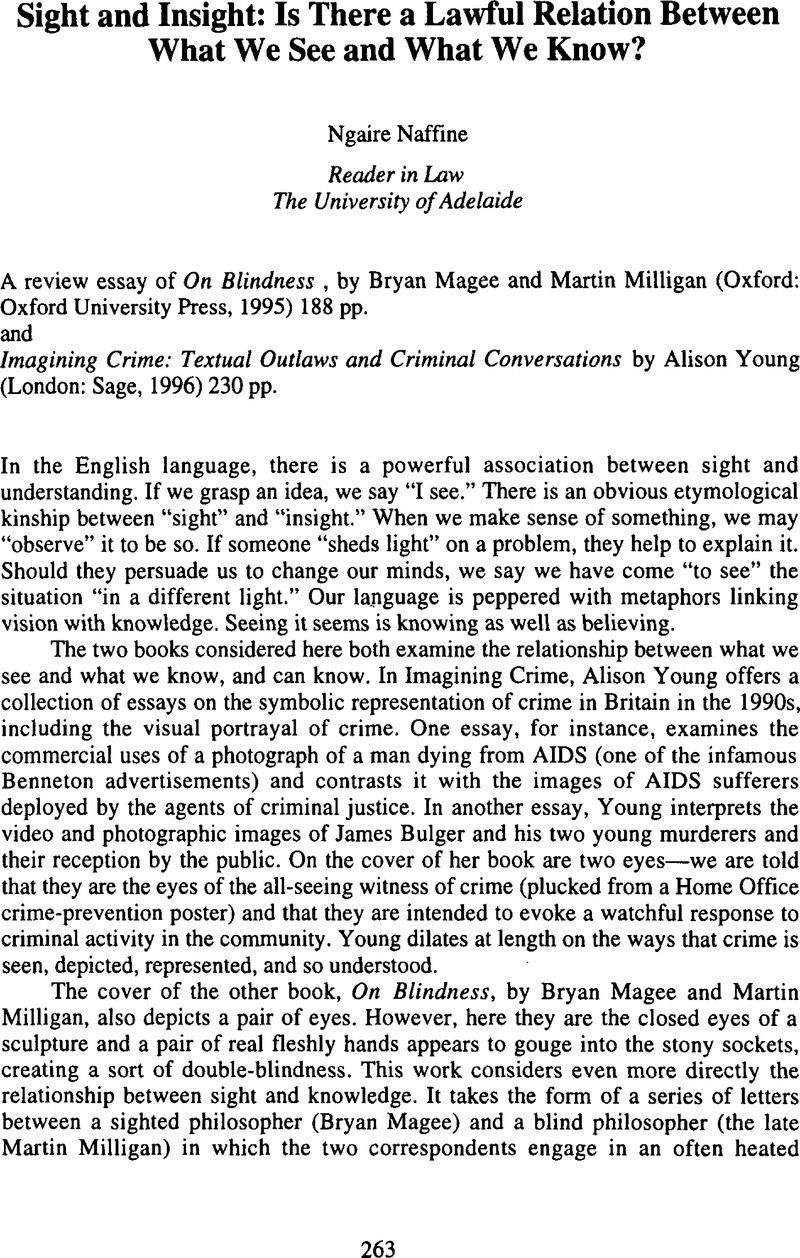No CrossRef data available.
Article contents
Sight and Insight: Is There a Lawful Relation Between What We See and What We Know?
Published online by Cambridge University Press: 18 July 2014
Abstract

- Type
- Review Essay/Note critique
- Information
- Canadian Journal of Law and Society / La Revue Canadienne Droit et Société , Volume 12 , Issue 1 , Spring/printemps 1997 , pp. 263 - 272
- Copyright
- Copyright © Canadian Law and Society Association 1997
References
1. Schopenhauer, A., The World as Will and Representation, ii 77Google Scholar quoted in Magee & Milligan.
2. Heydon, D., Cross on Evidence, 5th ed., (Sydney: Butterworths, 1996) at 46–47Google Scholar.
3. Ligertwood, A., Australian Evidence, 2d ed. (Sydney: Butterworths, 1993) at 354Google Scholar.
4. Legal recognition of the effects of cultural difference on perception remains the exception rather than the rule. See, for example, the discussion of cultural defences in Laster, K. & Raman, P., “Law for One and One for All? An Intersectional Legal Subject” in Naffine, N. & Owens, R., eds., Sexing the Subject of Law (Sydney: Law Book, 1997) 193Google Scholar. The implicit assumption of adjectival law is that those from the cultural mainstream are free from these limiting effects of culture.
5. As opposed, say, to hearing.
6. Although he describes sight as “elemental,” he suspects that touch may be the most important sense.
7. Indeed, according to Milligan, , “sighted people have got into the habit of disregarding a lot of the information the other senses provide” (pp. 3–4)Google Scholar and he proceeds to explain how the blind construct an alternative world of touch.
8. Wittgenstein, L., Philosophical Investigations (Oxford: Basil Blackwell, 1958) at 132Google Scholar.
9. Locke, J., An Essay Concerning Human Understanding, abridgement selected by Yolton, J. W (London: J. M. Dent, 1977) at 67Google Scholar.
10. Ibid.
11. Sacks, O., An Anthropologist on Mars (Sydney: Picador, 1995) at 108Google Scholar.
12. Ibid. at 111.
13. That is, the world as it makes itself available to the human senses.
14. Kant, I., Critique of Pure Reason, trans. Meiklejohn, J. M. D. (London: Everyman's Library, 1974)Google Scholar.
15. Geertz, C., The Interpretation of Cultures (London: Fontana, 1973) at 49Google Scholar.
16. Ibid.
17. Ibid. at 53.
18. The very idea of distortion is however problematic for the postmodernist, as we will see below. The reason is that it logically entails the possibility of the undistorted, the true, the accurate.
19. Tarnas, R., The Passion of the Western Mind: Understanding the Ideas that Have Shaped Our World View (New York: Ballantine, 1991) at 401Google Scholar. In this tradition, see for example Ecco, U., Faith in Fakes, trans. Weaver, W (London: Seeker & Warburg, 1986)Google Scholar.
20. Tarnas, ibid. at 406.
21. Ibid.
22. On the common law significance of “ocular inspection,” see I. Leader-Elliott, “Passion and Insurrection in the Law of Sexual Provocation” in Naffine & Owens, eds., supra note 4 at 149.


